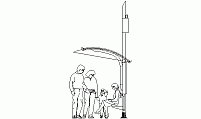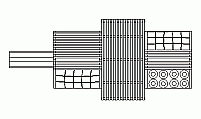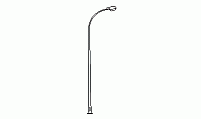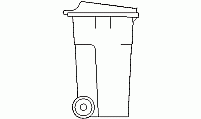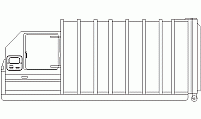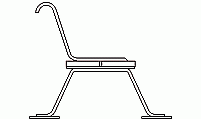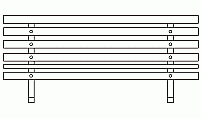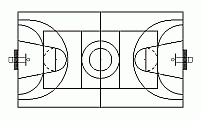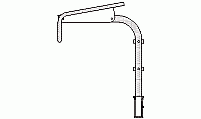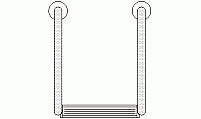CAD Blocks categories
 3D models
3D models home furniture
home furniture sanitary ware - bathrooms
sanitary ware - bathrooms professional equipment
professional equipment doors and windows
doors and windows people and animals
people and animals plants and trees
plants and trees vehicles - transports
vehicles - transports architectural details
architectural details mechanical - electrical
mechanical - electrical urban planning - civil works
urban planning - civil works safety health construction
safety health construction accessible design
accessible design drawing sheet
drawing sheet signals
signals construction machinery
construction machinery accessories and objects
accessories and objects maps and street maps
maps and street maps
Side Elevation Public Trash Bin CAD Block

size: 4 kb
category: street furniture
related categories:
description: Detailed side view of a public trash bin showing its conical design, structural vertical support, and slatted wall construction for urban waste disposal.
file extension: .dwg CAD - AutoCAD software
Classic Design and Technical Insights into Public Trash Bins
Functional Design of the Public Trash Bin
The public trash bin features a conical design that balances simplicity and functionality. Its circular structure has a wider top opening to facilitate waste disposal and a narrower base for enhanced stability. This design minimizes tipping, making it ideal for high-traffic public spaces like parks, streets, and urban plazas.
The top view of the bin in this CAD block shows evenly distributed vertical panels that form its walls. These panels are not only structural but also decorative, giving the waste bin a clean and modern appearance. This type of trash bin is often used in outdoor environments due to its robust design and practicality. Its compact size and conical shape make it easy to integrate into urban landscapes while maintaining functionality.
Dimensions and Capacity for Public Trash Bins
Public trash bins come in a variety of designs and sizes to accommodate different urban needs. Cylindrical bins are one of the most common types, typically featuring diameters ranging from 14 inches (35.5 cm) to 20 inches (50.8 cm), with heights between 28 inches (71.1 cm) and 36 inches (91.4 cm). These bins are widely used in parks and streets due to their simplicity and ease of use.
For areas requiring higher waste capacities, rectangular bins are often utilized. These bins usually measure 24 inches (61 cm) wide, 18 inches (45.7 cm) deep, and can stand up to 42 inches (106.7 cm) tall. They are ideal for busy locations like shopping centers or public transport hubs. Dual-compartment recycling bins are also increasingly popular, featuring two sections, each approximately 16 inches (40.6 cm) wide and 36 inches (91.4 cm) tall, to encourage proper waste segregation. Compact bins designed for pedestrian-heavy zones are smaller, with dimensions around 12 inches (30.5 cm) in diameter and 24 inches (61 cm) in height, making them perfect for narrow or confined spaces.
Frequently Asked Questions about Public Trash Bins
- How does the design of a conical trash bin improve waste disposal efficiency?
- Conical designs are particularly efficient for waste disposal because their wide openings make it easier for users to deposit trash. The narrowing base directs waste downward, maximizing the internal capacity and reducing blockages near the opening. This structure prevents overflow and maintains cleaner public areas.
- What role do public trash bins play in urban aesthetics?
- Modern trash bins complement the visual appeal of public spaces. Conical bins with vertical slats or sleek finishes integrate seamlessly with the architecture of parks, plazas, and streets. They enhance the aesthetic experience while serving a practical purpose, reflecting a city’s attention to design and cleanliness.
- Are these trash bins eco-friendly?
- Yes, many public trash bins are made from recycled materials such as stainless steel or high-density polyethylene (HDPE). Additionally, their designs often include separate compartments for recycling, promoting eco-friendly practices and reducing waste sent to landfills.
- Can public trash bins prevent wildlife interference?
- Yes, elevated trash bins with narrow openings and vertical slats are designed to deter animals from accessing the waste. This helps maintain hygiene and reduces the spread of litter caused by wildlife, particularly in parks and nature reserves.
- How do modular trash bins support easy maintenance?
- Modular designs allow parts of the bin, such as panels or the internal waste container, to be replaced or cleaned individually. This simplifies maintenance, minimizes downtime, and extends the lifespan of the bin without requiring complete replacement.
- What is the impact of trash bins on public health?
- Properly designed trash bins help contain waste, reducing the spread of waste-borne diseases. Features like odor-reducing ventilation and easy-to-clean surfaces further enhance hygiene, making trash bins essential for maintaining public health standards in urban spaces.
- Why is the height of the trash bin important?
- The height ensures ergonomic usability for people of all heights, including children and individuals with mobility challenges. Accessible bin heights encourage proper waste disposal and inclusivity in public spaces.
- How are public trash bins tested for durability?
- Trash bins are subjected to impact resistance tests, weather exposure simulations, and load capacity evaluations. These tests ensure the bins can withstand heavy use, environmental factors, and vandalism, making them reliable for urban settings.
- Can these trash bins include technology?
- Yes, modern trash bins can be equipped with smart sensors that monitor waste levels. These sensors alert maintenance teams when the bin is nearly full, improving collection efficiency and preventing overflow in busy areas.
- How do public trash bins contribute to waste education?
- Many public trash bins include signage or color-coded compartments for recycling, educating users on proper waste segregation. This promotes sustainable practices and encourages community participation in responsible waste management.
Benefits of Circular Trash Bin Designs
Circular trash bins are an excellent choice for public waste management due to their compact and practical design. The conical shape ensures stability by lowering the center of gravity, preventing the bin from tipping over in crowded or windy environments. Their wide top openings make waste disposal easy and efficient for users of all ages.
Compared to rectangular or cylindrical designs, circular trash bins provide better spatial integration, making them suitable for parks, sidewalks, and plazas. Their durable materials and ergonomic design minimize maintenance needs, while their aesthetic appeal enhances the overall appearance of public spaces. These features make them a preferred option for urban planners and architects.
Evolution of Public Trash Bins
Public trash bins have evolved significantly over time to meet the growing demands of waste management. Early designs were basic wooden or metal containers, often lacking the durability or capacity required for urban environments. By the mid-20th century, metal bins became standard, offering improved durability and resistance to environmental factors.
Modern public trash cans incorporate advanced materials such as stainless steel and HDPE, along with features like recycling compartments and anti-vandalism coatings. Today, they are designed not only for functionality but also for aesthetics, reflecting the cultural and environmental priorities of urban spaces. These advancements make trash bins an integral part of sustainable city planning.



